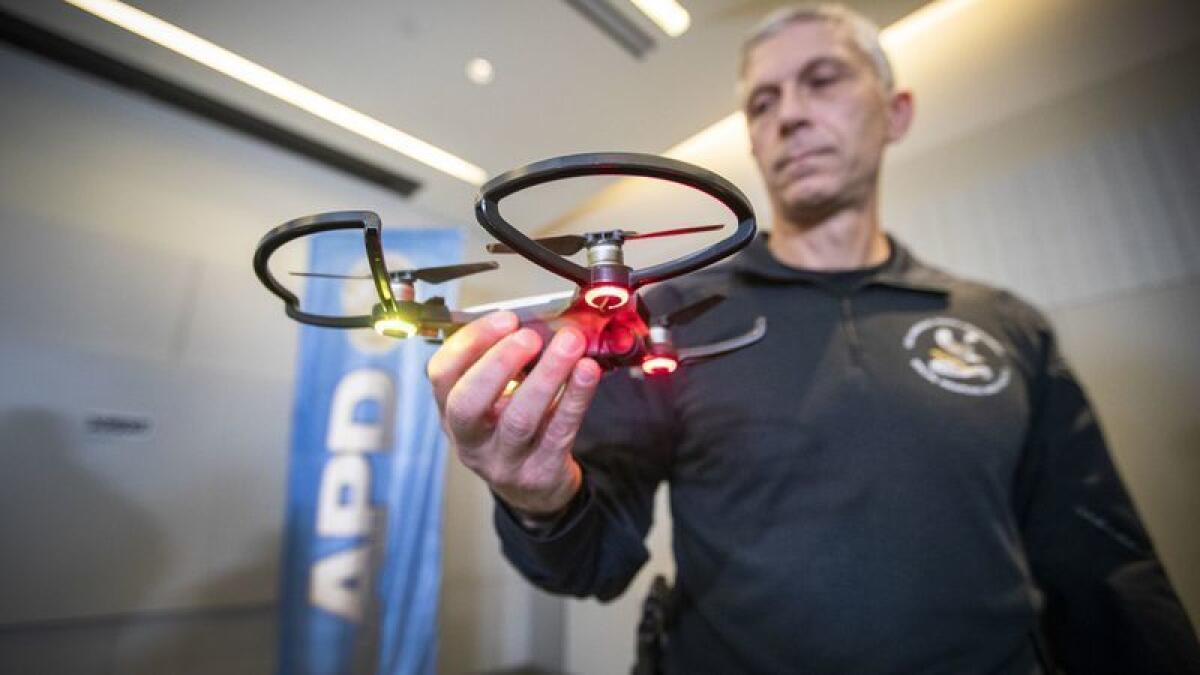LAPD wants to make drone program permanent and expand uses for the aerial devices

- Share via
The Los Angeles Police Department wants to permanently add drones to its arsenal and expand the use of the airborne devices to its bomb squad and hazardous materials unit and when officers use warrants to apprehend dangerous suspects.
The request comes two years after the five-member civilian Police Commission approved strict guidelines for police to use the remote-controlled devices in dangerous situations such as a barricaded suspect, active shooter or explosive device.
The commission will consider the request on Tuesday. If it’s approved, Police Chief Michel Moore said, the department will provide annual reports on the program.
Since January, SWAT officers received permission from top commanders to deploy the drone cameras in six incidents, but officers only used them in four cases, Moore wrote in a memo to police commissioners.
“This is indicative of the department’s sensitivity to the community’s privacy concerns and its commitment to utilizing the [drones] only when necessary,” Moore wrote, adding that drones reduce risks for officers, the public and suspects.
The department’s four drones vary in size and are no different from models commonly used by hobbyists.
Moore also asked commissioners to allow the department to upgrade the drones to a model specifically made for law enforcement. Among several features, the enhancements include an estimated flight time of 31 minutes, a spotlight, a speaker system and infrared and thermal sensors.
The LAPD’s drones are part of a pilot program approved in October 2017 by the Police Commission over the protests of residents and privacy advocates concerned that the devices would be used to spy on them.
A dozen SWAT officers were certified to fly them in last July, and the drones were deployed for the first time in January.
Under the rules of the pilot program, use of a drone must be approved by the deputy chief of the counter-terrorism bureau, and the police chief must be notified. The Police Commission required the LAPD to submit reports documenting each drone operation.
In 2017, the LAPD held forums across the city to pitch the use of the flying cameras. Critics complained the devices would infringe on privacy and would be flown far more than the LAPD had pledged.
Hamid Khan of the Stop LAPD Spying Coalition said Friday that critics feared the LAPD would seek to expand the program once drones became operational.
“This program was launched in extreme opposition to community concerns,” he said. “We absolutely reject the use. We knew this would happen.”
As of May 2018, according to the Center for the Study of the Drone at Bard College, nearly 600 local law enforcement agencies, along with nearly 200 fire departments and 100 emergency management agencies, had drones. The study noted that the number of agencies with drones increased by 82% in 2017.
Meanwhile, the drones provided a “real time video feed” in areas where officers could not physically observe suspects, Moore said.
Of the four incidents where officers deployed drones since January, three suspects were armed and barricaded in a home or apartment. The drones allowed officers to make sure suspects could not ambush officers, the memo said.
The latest deployment occurred June 15 when a shooting suspect hid in a large lot filled with tractor-trailers, vehicles and other clutter. Each incident ended peacefully.
In the two April incidents where officers had permission but didn’t use drones, each suspect had access to a high-powered weapon or rifle. Still, officers monitored one situation without the camera and convinced the other suspect to surrender, the memo said.
Moore stressed that SWAT officers were called to 78 incidents during the pilot program and only sought drone approval in six cases.
“Unmanned aircraft are a valuable de-escalation tool … to resolve incidents and reduce the likelihood of the use of force,” Moore said. “This pilot program demonstrated the department is capable of operating [drones] in a tactical environment while adhering to privacy and related public concerns.”
Times staff writer Cindy Chang contributed to this report.
More to Read
Sign up for Essential California
The most important California stories and recommendations in your inbox every morning.
You may occasionally receive promotional content from the Los Angeles Times.











